
Glory and the goddess of love: The center of the concentric colored circles is the pale yellow patch in the left half of the image. The glory extends over at least 1200 km. Not only visible light, but all wavelengths contribute to the glory. In order to also make the ultraviolet and infrared contributions visible, in this false-color representation each wavelength in the camera data is accounted for by a different color. Credit: ESA/MPS/DLR/IDA
Researchers have imaged a glory on Venus – a rainbow-like light phenomenon observed on cloud tops that helps to identify the components of the planet’s acidic cloud cover.
When traveling above the clouds, airplane passengers sometimes witness a glorious moment: a light phenomenon similar to a ring-shaped rainbow. Droplets in the clouds back-scattering the sunlight are responsible for this appearance. A team of scientists led by the Max Planck Institute for Solar System Research (MPS) in Göttingen have now fully imaged a glory on Venus – and thus for the first time on a planet other than Earth. The data was obtained by ESA’s space probe Venus Express. The data imply that the sulfuric acid in Venus’ cloud tops could additionally contain pure sulfur or iron chloride.
The veil of clouds surrounding Venus is as beautiful as it is hostile to life. Sulfuric acid constitutes their main component. Together with the planet’s dense atmosphere composed mainly of carbon dioxide, this cloud cover causes Venus’ extreme greenhouse effect. Temperatures of more than 400 degrees Celsius are common on the planet’s surface. The exact composition of the creamy-yellow clouds is still unclear. Almost 90 years ago, ground-based observations had shown that these clouds “swallow” ultraviolet light of certain wavelengths. Sulfuric acid alone cannot be responsible for this effect.
The list of possible candidates for the unknown substance is long: for example hydrobromic acid, amorphous sulfur, gaseous chloride, and even bacteria have been suggested. But no one substance could be identified with certainty. Now, the glory spotted in the data of Venus Express’s Venus Monitoring Camera may offer help. After all, the phenomenon occurs only under very special conditions: the droplets (or possibly solid crystals) in the clouds must be absolutely spherical and of uniform size. The width of the concentric rings and their relative intensities allow conclusion with regard to their size and refractive properties.
The most important precondition necessary to observe a glory is the observing position, explains Dr. Wojciech Markiewicz from the MPS, first author of the new study. This holds true both on Earth and Venus. The observer must be accurately located on a line between the clouds and the Sun. The droplets in the clouds scatter the sunlight back; the observer sees his own shadow on the cloud tops surrounded by colorful concentric circles.
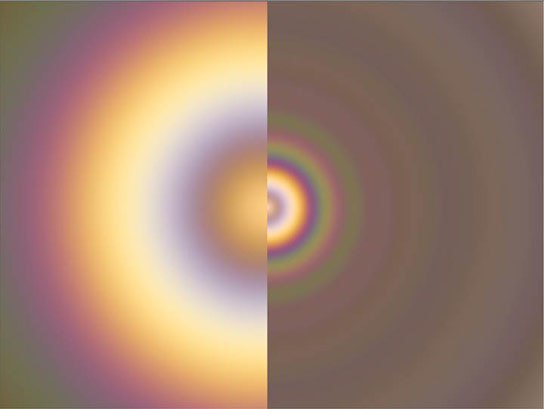
Simulated views of the glory phenomena on Venus (left) and Earth (right), without considering any effects of haze or background cloud brightness. Glories occur when sunlight shines on cloud droplets – water particles in the case of Earth, and sulfuric acid particles for Venus. The main difference between the appearance of the glory on Venus and on Earth is not because of composition, but rather the particle size. Cloud droplets on Earth are typically between 10 and 40 thousandths of a millimeter in diameter, but on Venus the droplets found at the cloud tops are much smaller, typically no more than 2 thousandths of a millimeter across. Because of this, the colored fringes are further apart than they would appear on Earth. Credit: C. Wilson/P. Laven
Since April 2011, the Venus Express spacecraft, that has been orbiting Venus since 2006, has been maneuvered into a suitable observing position more than twelve times. “In principle, our image, too, would show the shadow of the observing spacecraft”, says Markiewicz. However, approximately 6,000 kilometers (3,700 miles) lay between space probe and cloud tops. From this distance, the shadow of the spacecraft appears so small, that the camera cannot resolve it.
The resulting image is not only impressive, but also of high scientific value. In computer simulations, the researchers re-enacted the optical processes leading to the glory and tried to reconstruct their image as closely as possible. To this end, they varied parameters such as size and refractive index of the droplets. “In our calculations, we could not reconstruct the image with droplets consisting of sulfuric acid alone”, says Markiewicz. The scientists’ calculations show that an additional substance must be present. This may well be the long-sought unknown UV-absorber. Especially droplets of sulfuric acid with a core of iron chloride or an outer layer of pure sulfur proved to be promising candidates.
Reference: “Glory on Venus cloud tops and the unknown UV absorber” by W.J. Markiewicz, E. Petrova, O. Shalygina, M. Almeida, D.V. Titov, S.S. Limaye, N. Ignatiev, T. Roatsch and K.D. Matz, 13 February 2014, Icarus.
DOI: 10.1016/j.icarus.2014.01.030


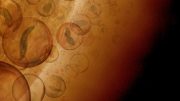


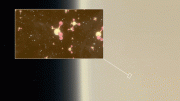
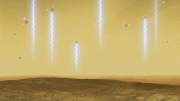

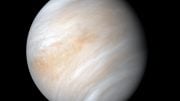
Be the first to comment on "Rainbow-Like Light Phenomenon Observed on Venus for the First Time"